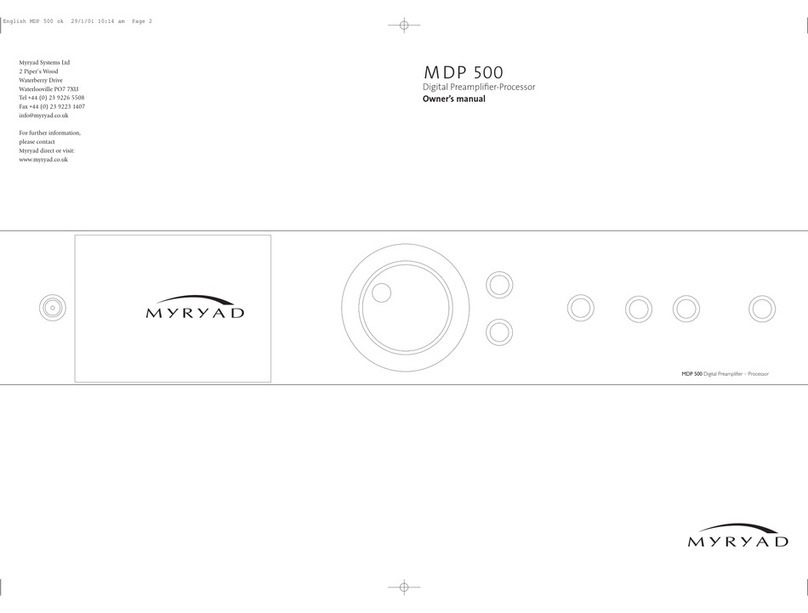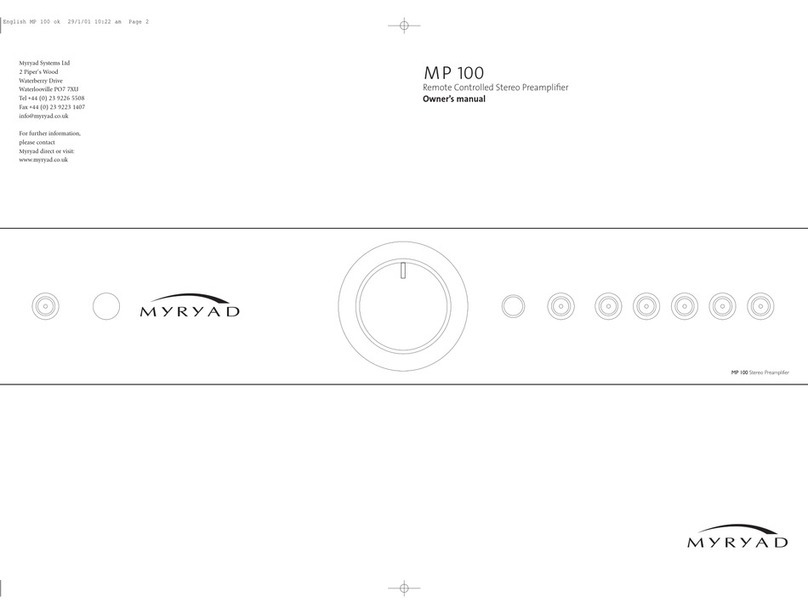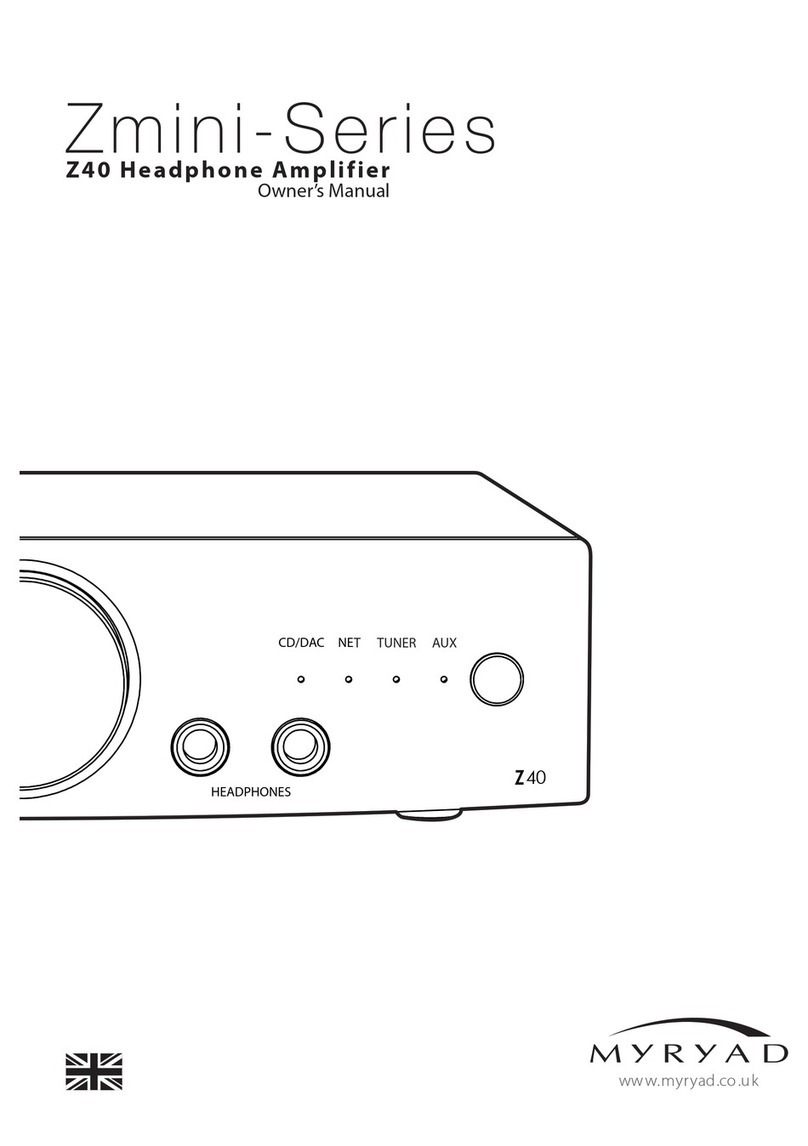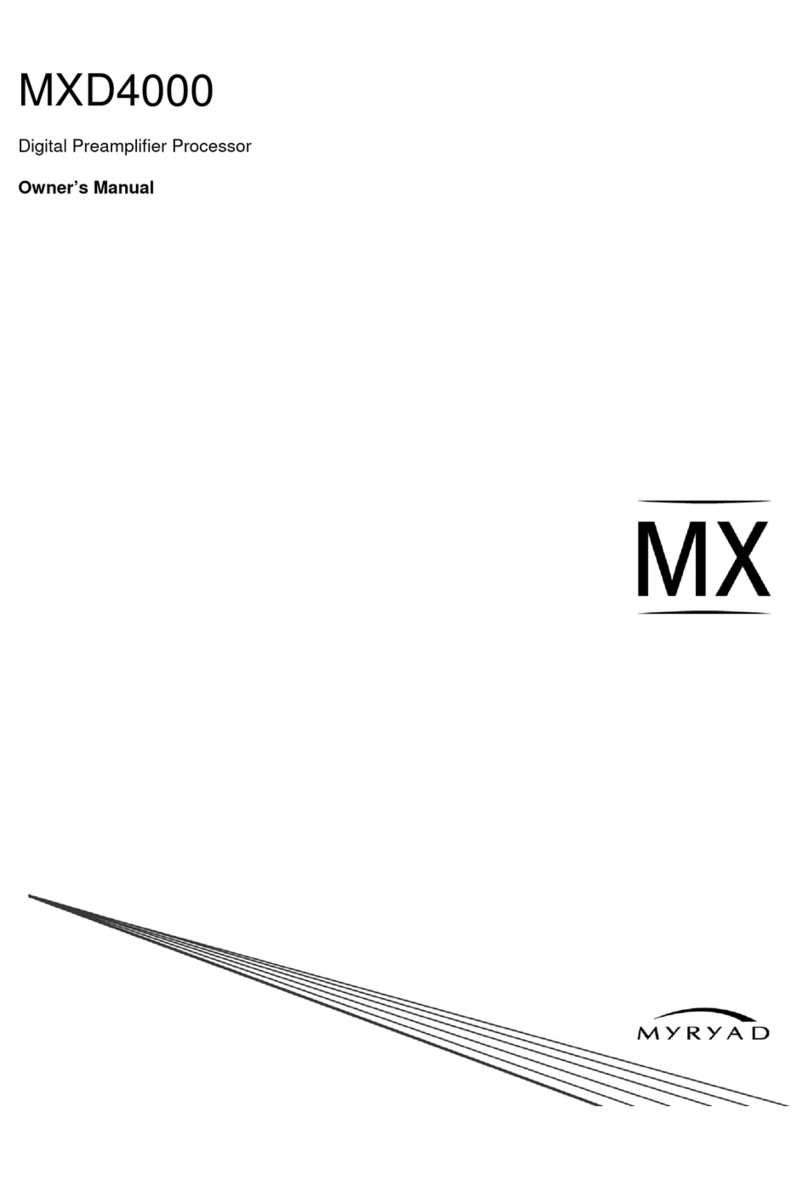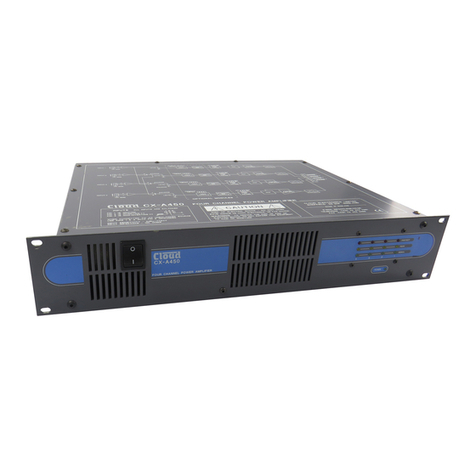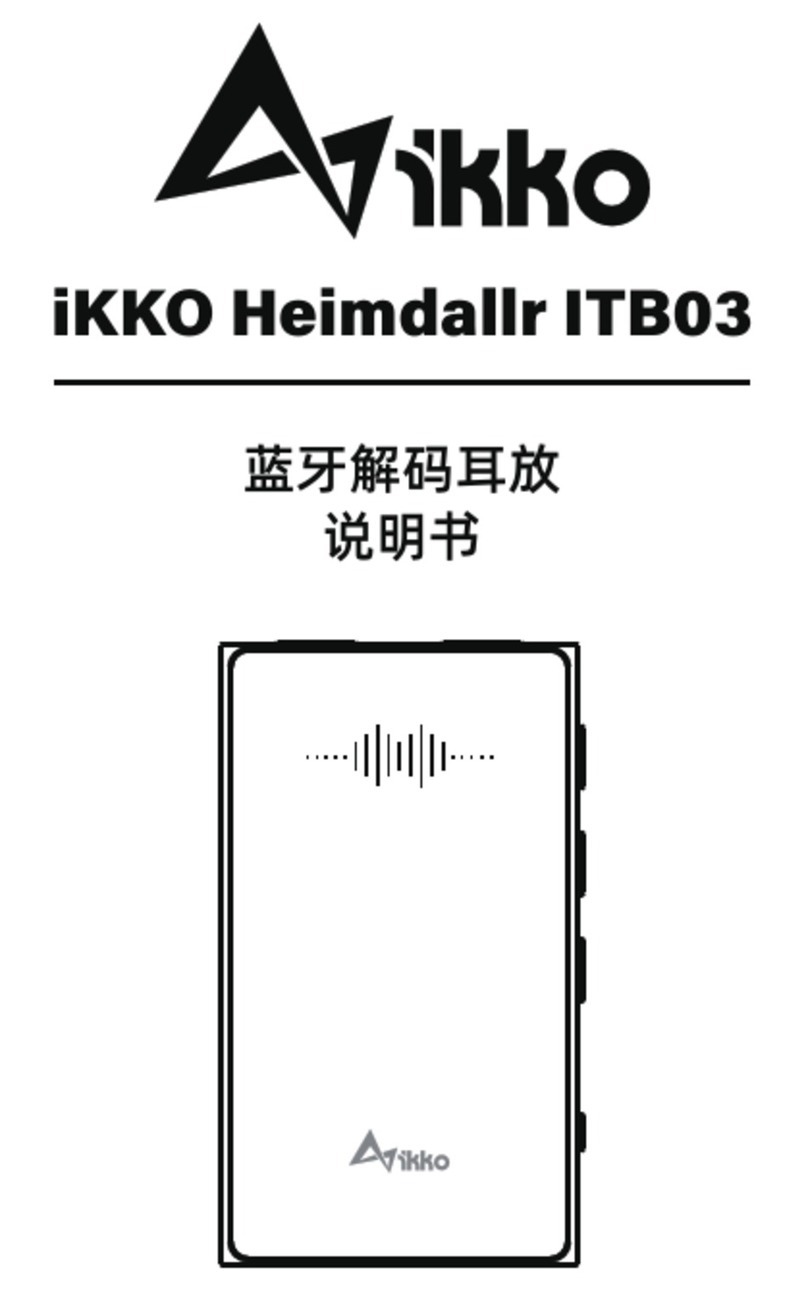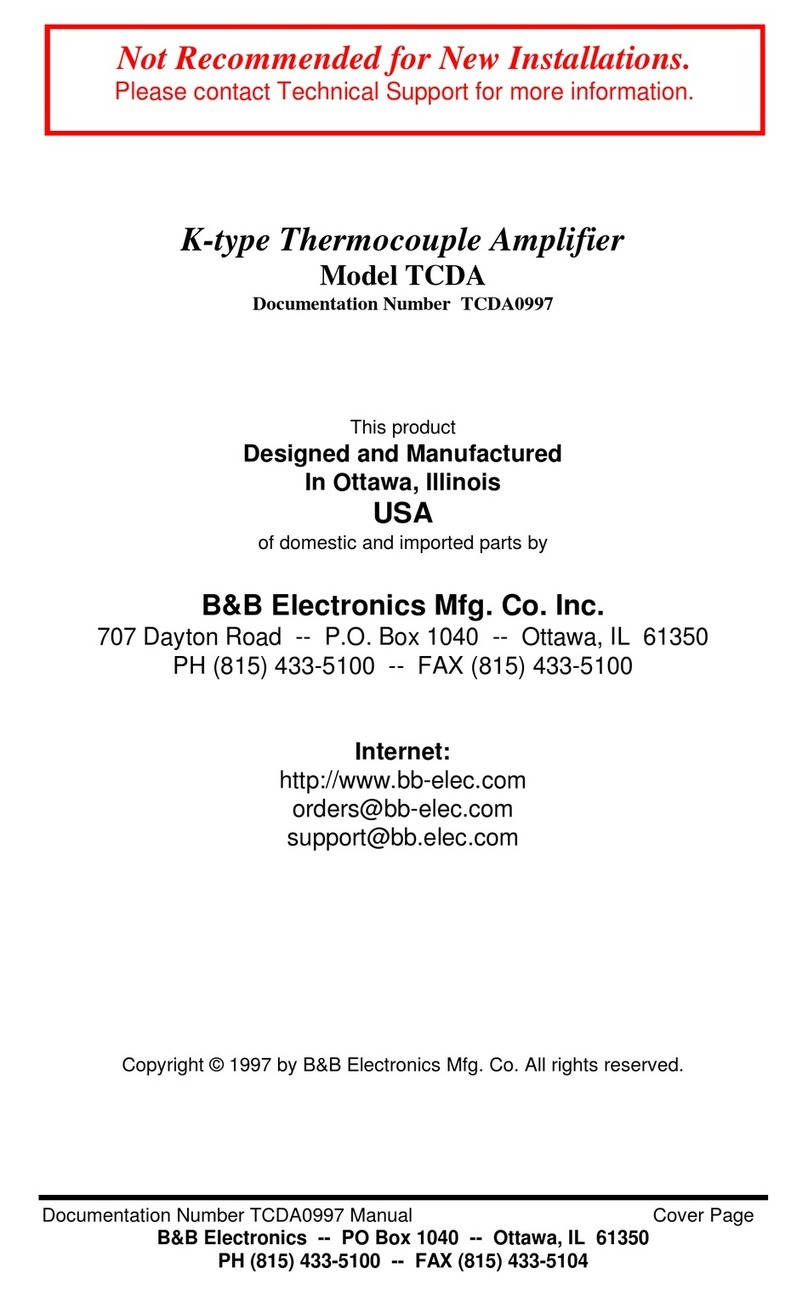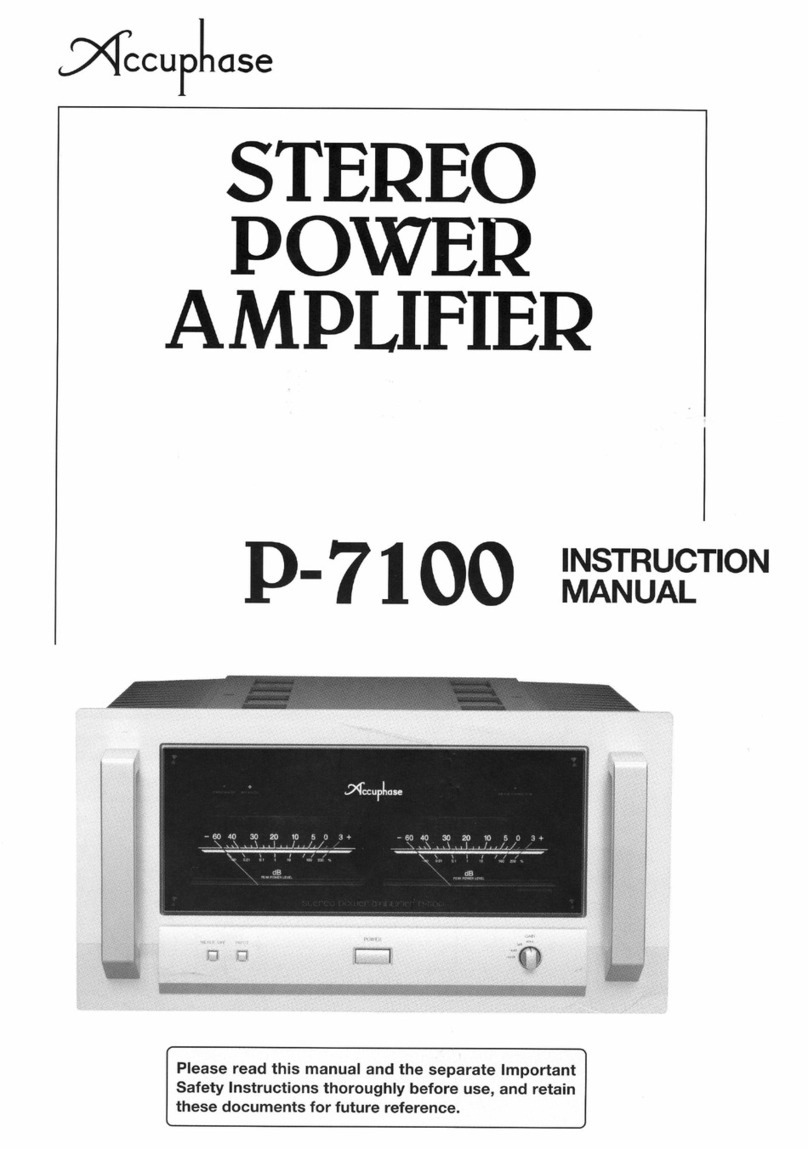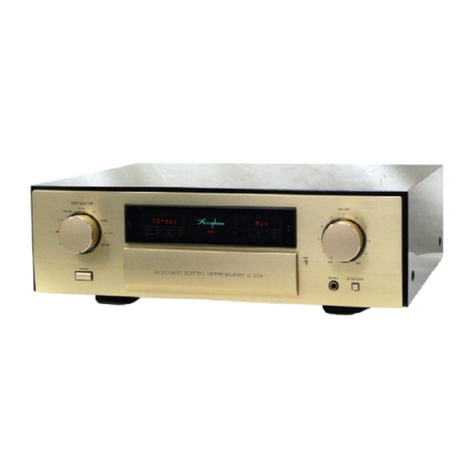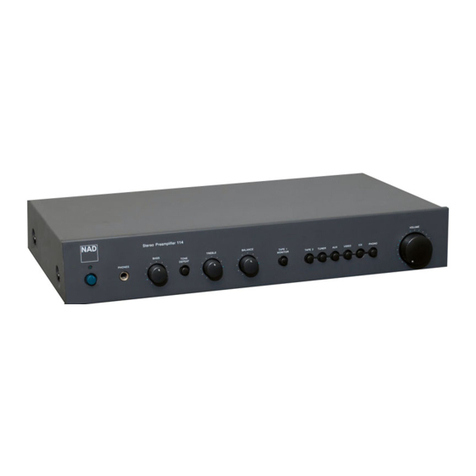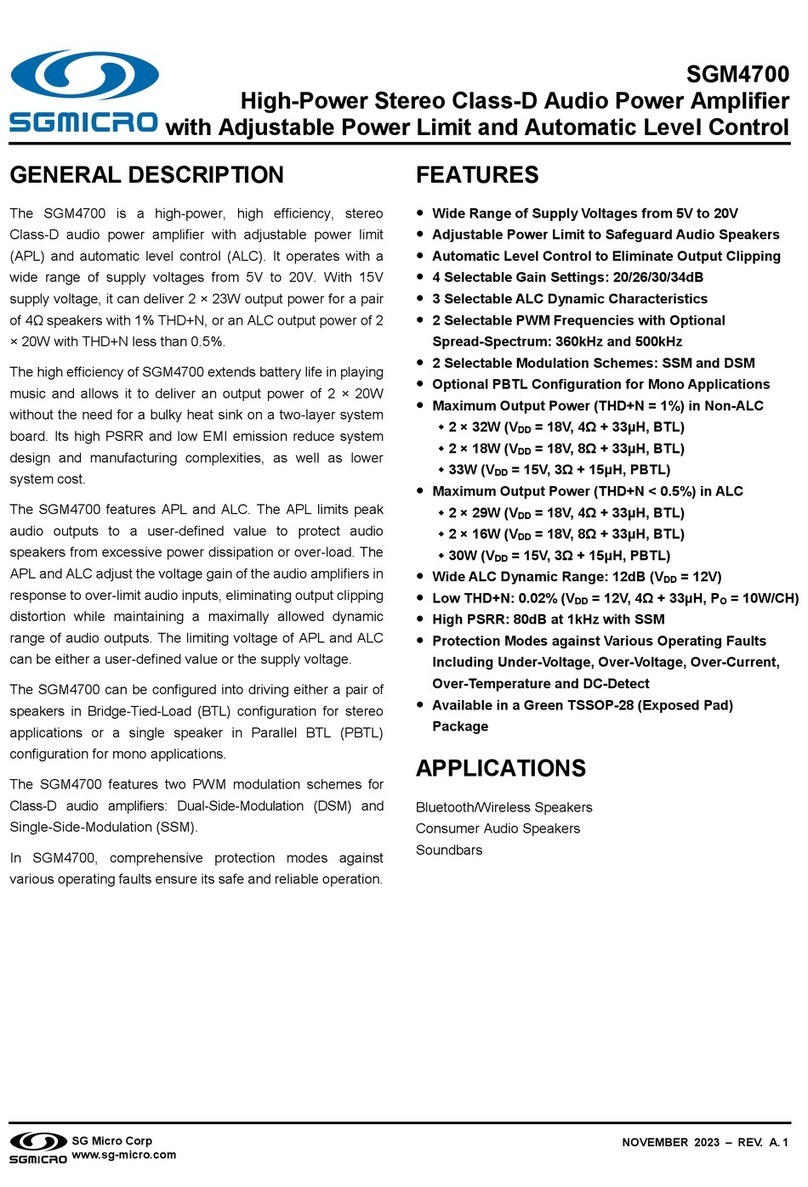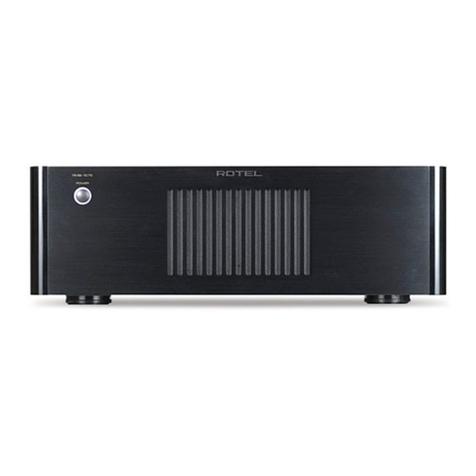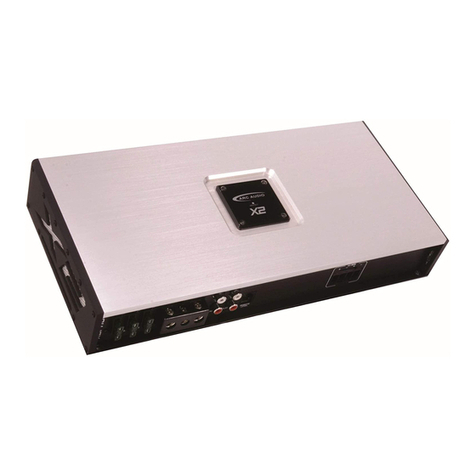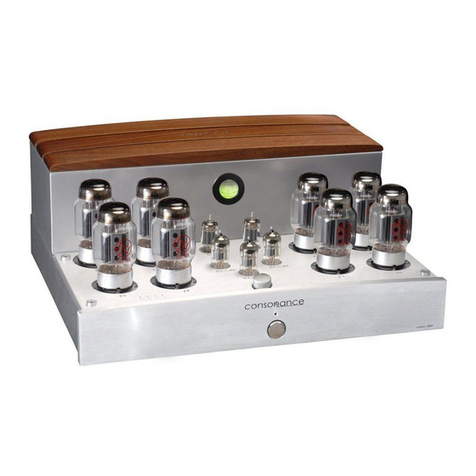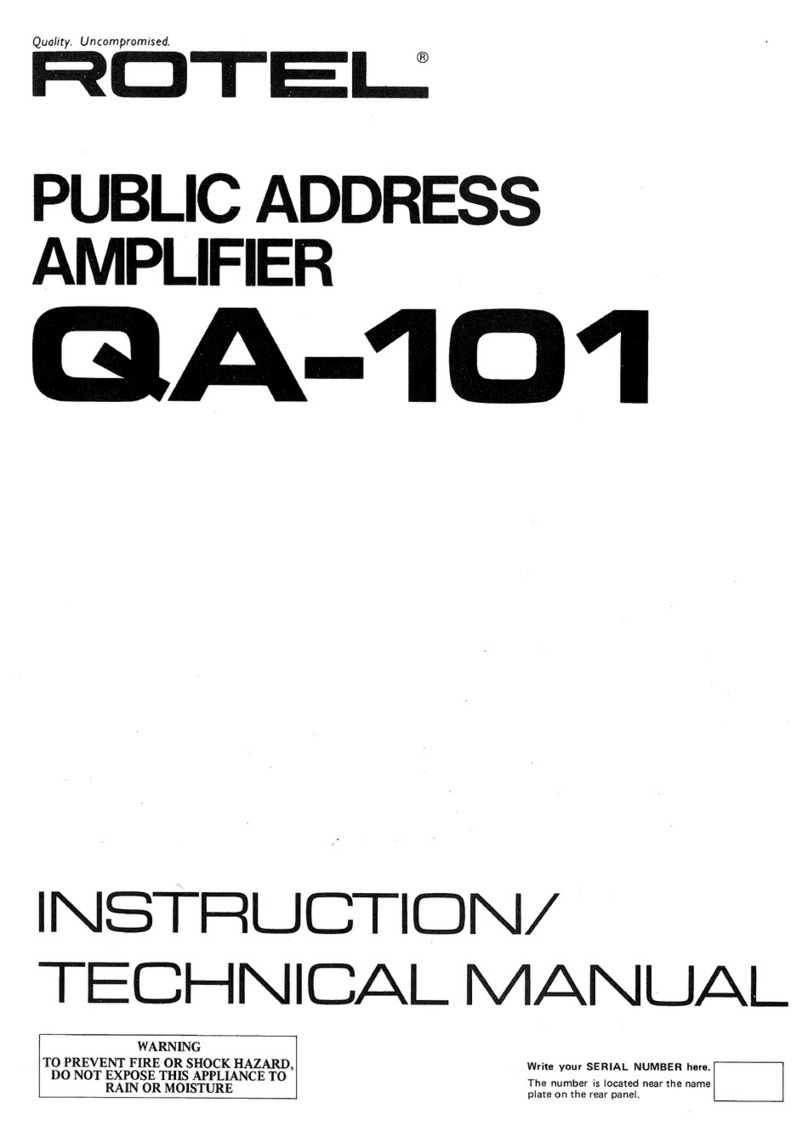Myryad MA120 User manual

ma 120/240/360
Power Amplifiers
Owner’s manual
Myryad Systems Ltd
2 Piper’s Wood
Waterberry Drive
Waterlooville PO7 7XU
Tel +44 (0) 23 9226 5508
Fax +44 (0) 23 9223 1407
For further information,
please contact
Myryad direct or visit:
www.myryad.co.uk
STANDBY
MA 120 Stereo Power Amplifier
English MA 120-240 ok 29/1/01 10:06 am Page 2

3
2
introduction
The Myryad MA 120, 240 and 360 Power
Amplifiers have been designed to offer
a combination of high quality sound
reproduction and simple yet elegant styling.
They can be used to provide power for high
quality stereo systems when partnered by a
suitable preamplifier such as Myryad’s MP
100, or with a Myryad integrated amplifier in
bi-amp or tri-amp systems. They can also be
used, in combination (e.g. one MA 240 Stereo
Power Amplifier plus one Myryad MA 360
Three Channel Power Amplifier), to power a
full-surround music or Home Cinema sound
system of the highest quality.
The MA 120 and MA 360 have unbalanced
line inputs plus directly linked line outputs,
all on RCA phono sockets.
The MA 240 also has unbalanced line inputs
plus directly linked line outputs, all on
RCA phono sockets but it in addition it has
balanced line inputs on professional quality
3-pin XLR sockets. Furthermore, the two
amplifier channels may be switched to
bridged-mono mode for increased power
output into a single 8Ω loudspeaker using a
rear panel switch.
All Myryad M-Series Power Amplifiers may
be controlled remotely via the My-Link
communications bus when used with other
Myryad M series products. The My-Link
allows remote control of standby and mute
functions. In addition to this, the MA 240
and MA 360 power amplifiers may be
switched into or out of standby remotely
using their DC trigger inputs.
MA 120 applications include:
•Stereo operation, delivering 2 x 60 watts
into 8Ω loudspeakers
•One MA 120 with an MI 120 Integrated
Amplifier in a bi-amplifier system
•Two MA 120s with an MP 100
Preamplifier in a bi-amplifier system
•Three MA 120s with an MP 100
Preamplifier in a tri-amplifier system
•Up to ten MA 120s and one MI 120 or
MP 100 in a multi-room system
MA 240 applications include:
•Stereo operation, delivering 2 x 120 watts
into 8Ω loudspeakers
•High power stereo operation with two
MA 240s – able to deliver 2 x 400 watts
into a minimum 8Ω load
•Stereo bi-amplifier operation with two
MA 240s, each delivering 2 x 120 watts into
8Ω loudspeakers
•Use in conjunction with the MA 360 Three
Channel Power Amplifier, delivering five
channels at 120 watts into 8Ω in Home
Cinema systems of the highest quality
MA 360 applications include:
•Use in conjunction with the MA 240 Stereo
Power Amplifier, delivering of five channels
at 120 watts into 8Ω in Home Cinema
systems of the very highest quality.
PLEASE NOTE:THIS OWNER’S MANUAL
DESCRIBES ALL THREE POWER AMPLIFIERS.
WHERE THE TEXT APPLIES TO ONLY ONE OR
TWO OF THE AMPLIFIERS THE APPLICABLE
MODEL NUMBER(S) APPEAR IN THE PARAGRAPH
HEADING. WHERE NO MODEL NUMBER IS
SPECIFIED IN THE PARAGRAPH HEADING THE
TEXT APPLIES TO ALL POWER AMPLIFIERS.
installation and
safety notes
This amplifier generates a modest amount
of heat and thus requires ventilation. Do
not place it on a rug or other soft surface
into which it could sink, obstructing the air
inlets in its underside. Do not allow papers
or cloth to obstruct the ventilation grille in
the top cover. The amplifier should not be
installed in a built-in situation such as
a bookcase or cabinet that may impede
the flow of air. If the amplifier is moved
shortly after operation take care not to touch
the heatsinks, which are accessible from
below, as they may be very hot. The amplifier
is designed for use in moderate climates.
CAUTION:TO PREVENT A FIRE OR SHOCK
HAZARD, DO NOT PERMIT THIS PRODUCT TO
BECOME WET OR EXPOSE IT TO DRIPPING OR
SPLASHING. DO NOT PLACE OBJECTS FILLED
WITH LIQUID, SUCH AS VASES, ON THE
AMPLIFIER. IF LIQUID IS ACCIDENTALLY SPILLED
ON IT, IMMEDIATELY SHUT OFF ITS POWER AT
THE WALL SOCKET AND UNPLUG THE AC
POWER CORD. ALLOW SUFFICIENT TIME FOR
COMPLETE EVAPORATION TO OCCUR BEFORE
OPERATING THE AMPLIFIER AGAIN. IF THE
LIQUID IS ANYTHING BUT WATER AND/OR
ALCOHOL, A QUALIFIED SERVICE TECHNICIAN
SHOULD EXAMINE THE AMPLIFIER BEFORE IT
IS USED AGAIN.
DO NOT PLACE NAKED FLAMES, SUCH AS
LIGHTED CANDLES ON THIS PRODUCT. DO
NOT REMOVE THE COVER, OR ATTEMPT TO
MODIFY OR REPAIR THE AMPLIFIER YOURSELF.
REFER ALL SERVICING TO A QUALIFIED
TECHNICIAN.
accessories
Your Myryad Power Amplifier is supplied
complete with the following accessories:
MA 120,MA240 and MA 360
•Separate mains power cord to suit
country of sale.
MA 240 only
•Two “U”-shaped gold-plated XLR jumper
links. Supplied inserted into the
BALANCED input sockets. {If you remove
these links from the amplifier store them
in a safe place as they may be needed in
the future.}
contents
• Introduction 3
• Installation and safety notes 3
• Accessories 3
• Setting up your systems 4
• Rear panel connections 5
• Operating your system 7
• Front panel controls 7
• Loudspeaker output 7
protection and muting
• Trouble-shooting guide 8
• Appendix 9
• The MI 120 plus MA 120 in
“Bi-Amplified” Systems
• Using the MA 240 with an MI 120
or mixed MA 120s and MA 240s
with an MP 100 in Bi-Amp or
Tri-Amp systems
• The MI 120 plus MA 120s in
“Tri-Amplified” systems
• The MI 120 or MP 100 with one
or more 120s or MA 240s in
Multi-Room systems
• My-link 10
• Specifications 15
English MA 120-240 ok 29/1/01 10:06 am Page 2

5
4
rear panel
connections
1Power inlet
Before making any connection, check that the
mains voltage setting printed on the rear
panel is the same as your local mains supply.
Plug the female (socket) end of the power
cord into the power inlet on the rear of the
amplifier. Plug the male (plug) end of the
cord into a“live” wall socket or a suitable
heavy-duty extension cable.
UK version: The mains plug is supplied fitted
with a 5A fuse. It should only be replaced
with a fuse of the same rating (5A) which
complies with BS1362.
2Power switch
Press one side of this rocker switch (the side
nearer the edge of the rear panel) to switch
amplifier ON and the other side (towards the
speaker terminals) to switch it OFF. When the
POWER switch is in the OFF position all
power is disconnected from the amplifier. In
this condition the amplifier cannot be
powered up from the front panel or the My-
Link (or remote trigger if present). When the
POWER switch is in the ON position (and
the power cord correctly inserted and plugged
in to a live wall socket) the amplifier will
power up in standby mode (see FRONT
PANEL CONTROLS, STANDBY,).
It is recommended that the POWER switch be
turned OFF if the amplifier is not going to be
used for an extended period of time.
3My-link input/output
When this Power Amplifier is used in a
system with other Myryad M-Series products
all may be joined together via the My-Link.
This will allow the different products to be
remotely controlled via the infra-red receiver
on, for example, an MP 100 Preamplifier. My-
Link offers two benefits. Firstly, only the MP
100 Preamplifier infra-red receiver needs to be
in “line-of-sight” from the remote handset.
Secondly, the My-Link allows remote control
of some Myryad products which do not have
their own infra-red receiver, such as the
Myryad Power Amplifiers.
When joined via the My-Link, the Power
Amplifier will respond to STANDBY and
MUTE operations on the MP 100 Preamplifier
i.e.: if both the MP 100 Preamplifier and the
Power Amplifier are in STANDBY, then
switching the MP 100 Preamplifier out of
standby will also bring the Power Amplifier
out of standby. In this way the MP 100 + MA
240 (or MA 120) can be operated with the
same ease as an integrated amplifier. If Power
Amplifiers are being used in a bi-amp or
tri-amp system all the amplifiers may be
My-Linked so that they can be controlled as
one from the Myryad preamplifier.
NOTE: SWITCHING THE POWER AMPLIFIER
INTO STANDBY WILL NOT SWITCH THE MP 100
PREAMPLIFIER INTO STANDBY.
MA 240 and MA 360 only:
When the My-Link is connected it is
recommended that no connection be made to
the REMOTE TRIGGER input (see below).
4Remote trigger control input/output
(MA 240 and MA 360 only)
If the MA 240/360 is being used in a system
without a Myryad M-Series preamplifier,
processor or integrated equipped with My-
Link, the REMOTE TRIGGER input may be
used to allow the MA 240/360 to be remotely
switched into or out of STANDBY.
If your preamplifier or processor has a
TRIGGER output which delivers a DC trigger
signal when the unit is switched on (or out
of standby) then it can be linked to the
MA 240/360 to switch the MA 240/360 out
of/into standby also. A lead must be used
which is fitted with a 3.5mm mini-jack plug
to connect to the MA 240/360’s REMOTE
TRIGGER input socket. The lead must be
wired according to the rules below:
•Connector to MA 240/360 REMOTE
TRIGGER input: 3.5mm mini-jack plug
•Jack plug wiring: sleeve negative,
tip positive
• Trigger voltage: DC, 4.5V to 24V
•Nominal loading of MA 240/360
REMOTE TRIGGER input: 2200Ω
•TRIGGER voltage change from 0 to +ve:
Amplifier switched from standby to active
•TRIGGER voltage change from +ve to 0:
Amplifier switched from active to standby
If you are in any doubt about meeting any of
these criteria or preparing a suitable lead, ask
your dealer or installer to handle this for you.
NOTE: IF THE TRIGGER INPUT IS ACTIVE
WHEN THE REAR PANEL POWER SWITCH IS
TURNED ON, THEN THE AMPLIFIER WILL
NOT POWER UP INTO STANDBY MODE AS
USUAL. IT WILL POWER UP IMMEDIATELY
INTO ITS “ACTIVE” STATE – WITH ITS NORMAL
POWER-ON MUTE DELAY (SEE FRONT PANEL
CONTROLS, STANDBY BELOW).
The REMOTE TRIGGER output is wired
directly to the input. Using this output,
further MA 240/360s, or other products, may
be connected from a single trigger source
without needing any special adaptors.
5Loudspeaker outputs
The loudspeaker outputs are capable of
driving all loudspeakers with impedances in
the range 4Ω to 16Ω (except the MA 240 in
Bridget-Mono – see below).The loudspeaker
terminals are high-current binding-posts,
coded red and black. The terminals on the
left side of the amplifier (viewed from the
front) and marked “L” should be wired to the
left hand loudspeaker. Those on the right,
marked “R”, should be wired to the right
hand loudspeaker.
CAUTION:THE RED TERMINALS ARE MARKED
WITH A HAZARD SYMBOL ~TO INDICATE
THAT THEY CAN BE LIVE. READ ALL THE
LOUDSPEAKER WIRING INSTRUCTIONS
CAREFULLY. IT IS RECOMMENDED THAT READY-
MADE LEADS BE USED WHERE POSSIBLE.
For correct stereo imaging it is important that
the two loudspeakers are wired “in phase”.
To ensure correct phasing wire the black (-)
terminal on the amplifier to the black or “–”
terminal on the loudspeaker. The red (+)
terminal on the amplifier should be wired to
the red or “+” terminal on the loudspeaker.
The loudspeakers should be positioned
as recommended by the loudspeaker
manufacturer. The two loudspeakers should
always be placed at equal distances from the
main listening position and usually spaced
a similar distance apart. It is generally best
to keep the loudspeakers away from room
corners and many loudspeakers work best
away from all walls.
MA 240 only
When the MA 240 is switched to BRIDGED-
MONO mode, only the red speaker terminals
are used. No connection should be made to
either of the black terminals. For correct
phasing connect the Left hand red (+)
terminal on the amplifier to the red or “+”
terminal on the loudspeaker and connect the
Right hand red (+) terminal on the amplifier
to the black or “–” terminal on the
loudspeaker. Each amplifier and loudspeaker
should be connected in the same way.
CAUTION: WHEN THE MA 240 IS SWITCHED
TO BRIDGED-MONO MODE, EACH AMPLIFIER
DRIVES INTO ONLY HALF THE SPEAKER
IMPEDANCE SO LOUDSPEAKERS RATED AT LESS
THAN 8Ω IMPEDANCE MUST NOT BE USED.
setting up your
systems
MA 120 Stereo Power Amplifier
MA 240 Stereo Amplifier
MA 360 Three Channel Power Amplifier
my-link
out in
rl
rl power
onoff
input
line
output
balanced input
connections
unbal link
1
2
3
+
–
+
–
out
in
right channel
balanced normal
+
–
out
in
left channel (mono)
balanced
normal
stereo
bridged
mono
rl
out
in
my-link remote
trigger
out
in
35mm jack
tip +, sleeve –
4.5v - 24v dc
power
onoff
35mm jack
tip +, sleeve –
4.5v - 24v dc
out
in
channel 2channel 1
out
in
channel 3
out
in
213
out
in
my-link remote
trigger
out
in
power
on
off
English MA 120-240 ok 29/1/01 10:06 am Page 4

7
front panel
controls
1 Standby
When the amplifier is plugged into a live
wall socket and the POWER switched is
turned ON, it will power up in "standby"
mode and the LED (Light Emitting Diode)
in the STANDBY button will glow red. In this
mode the internal circuitry of the MA 240 is
powered up, but disabled so that it consumes
very little power and is isolated by relays at
its outputs.
When the STANDBY button is pressed
the amplifier circuitry will be activated
and the LED will flash green. After a few
seconds delay the loudspeaker outputs
will be connected to the amplifier and
the LED in the STANDBY button will glow
green continuously. (The mute delay in
the MA 120 is about 4 seconds, but in the
MA 240 and 360 it is about 8 seconds to
allow for the longer settling time of the
larger amplifiers’ circuits.)
PLEASE NOTE:WHEN THE POWER AMPLIFIER
IS REMOTELY ACTIVATED FROM ANOTHER
UNIT,THERE WILL BE A BRIEF DELAY BETWEEN
THE CLOSING OF THE OUTPUT RELAYS OF THE
TWO UNITS. THIS IS NORMAL AND NO CAUSE
FOR CONCERN.
When the STANDBY button is pressed again
the amplifier will be returned to standby
mode. The LED in the STANDBY button will
change back to red.
CAUTION:WHEN IN STANDBY MODE THE
INTERNAL CIRCUITRY OF THE MA 120,240 OR
360 IS STILL LIVE, SO ALL SAFETY PRECAUTIONS
MUST BE FOLLOWED.
loudspeaker
output protection
and muting
When the amplifier is in standby mode the
loudspeaker output terminals are isolated
from the amplifier by a high quality relay.
When the amplifier is first switched on from
standby mode the loudspeaker outputs
remain disconnected for a few seconds to
allow the internal voltage levels to settle.
The loudspeaker outputs are immediately
disconnected again when the amplifier is
switched back into standby mode.
The same loudspeaker mute relay is used
to protect both the amplifier and your
loudspeakers against possible damage. If any
one of a number of fault modes is detected
(loudspeaker outputs short circuit, amplifier
overheating, amplifier DC fault) the
loudspeakers will be disconnected from the
amplifier to protect both. In the case of a
short circuit or DC fault the loudspeakers will
be re-connected after a few seconds, but will
be disconnected again if the fault persists. If
overheating has caused the protection system
to operate, then it will take some time for the
heatsinks to cool sufficiently to allow the
loudspeakers to be re-connected (probably
between five and fifteen minutes depending
upon the room temperature and ventilation).
The amplifier will cool more quickly if it is
switched to standby mode, or if the POWER
is switched OFF.
6
MA 360 only
The three channels in the MA 360 may be
assigned in a variety of ways in Home
Cinema systems. The two most common are:
channels 1 and 2 for left surround and right
surround, with channel 3 for front centre
(using an MA 240 for left front and right
front) or, channels 1, 2 and 3 for left front,
centre and right front (using an MA 240 for
left surround and right surround). In each
case make sure all loudspeakers are wired
“in phase” as described above.
6Line inputs – normal (unbalanced)
The NORMAL unbalanced line inputs can
be driven from the line outputs of any good
quality stereo preamplifier (such as the
Myryad MP 100) or any other suitable line
level source. High quality phono-to-phono
(RCA-to-RCA) interconnects should be used.
MA 240 only
Note: when using the NORMAL line inputs
the two XLR jumper links (“U”-shaped gold-
plated links)
must
be inserted into the
BALANCED input sockets on each channel
(between pins 1 and 3 as indicated on the
rear panel). The MA 240 is always shipped in
this condition. Failure to insert these links
will result in reduced input sensitivity and
possibly some background hum, but it will
not endanger the amplifier.
7Line outputs – normal (unbalanced)
Each channel’s line output is directly
connected to its line input – without buffering.
The line output allows power amplifiers to be
“daisy-chained” so that bi-amp, tri-amp and
multi-room systems may be built. For a more
detailed discussion of bi-amping, tri-amping
and multi-room installations please refer to
the Appendix. Only unbalanced line outputs
are fitted.
8Line inputs – balanced (MA 240 only)
The BALANCED line inputs can be driven
from the balanced line outputs of any good
quality stereo preamplifier (such as the
Myryad MP 100) or any other suitable line
level source. High quality XLR-to-XLR
balanced interconnects should be used.
In order to use the BALANCED line inputs
the two XLR jumper links ( the “U”-shaped
gold-plated links plugged into the
BALANCED input sockets) must first be
removed. Take care of these links and store
them in a safe place. They will be needed
again if the amplifier’s unbalanced inputs
are to be used.
9Bridged mono switch (MA 240 only)
The MA 240 is shipped with this switch in the
STEREO position, with the button pressed
in almost flush with the rear panel. In this
mode the MA 240 operates as a conventional
stereo amplifier as described above.
If the button is pressed to release it to the
“out” position, the MA 240 is switched to
BRIDGED MONO mode. The amplifier
then operates as a single channel “mono”
amplifier to drive just one loudspeaker, but at
a much higher power level (up to 400 watts
into 8Ω). A second power amplifier is needed
for stereo operation in this mode.
When operated in BRIDGED MONO mode
the following rules must be applied:
•Connect the line input signal to the LEFT
channel input, either NORMAL
(unbalanced) or BALANCED.
•Connect the loudspeaker between the two
RED (“+”) loudspeaker output terminals,
with the red or “+” terminal of the speaker
connected to the MA 240’s Left “+”
terminal and the black or “–” terminal of
speaker connected to the MA 240’s Right
“+” terminal.
CAUTION:WHEN OPERATING THE MA 240 IN
BRIDGED MONO MODE THE MINIMUM RATED
LOUDSPEAKER IMPEDANCE IS 8Ω.
standby
MA 120 Stereo Power Amplifier
operating your
system
English MA 120-240 ok 29/1/01 10:06 am Page 6

appendix
Systems building with the MI 120
Stereo Integrated Amplifier, the MP 100
Stereo Preamplifier and the MA 120 or
MA 240 Stereo Power Amplifiers
The MI 120 was designed to integrate into
a wide range of hi-fi systems and fulfil the
requirements of most listeners. However, we
realise that many people will want to expand
their system, either to enhance the sound
quality even further, or to extend the benefits
of their Myryad system into other rooms.
The MA 120 Power Amplifier was developed
to meet these needs with a minimum of
additional wiring and complexity.
For even higher quality sound and greater
flexibility the MP 100 preamplifier can be
used with one or more MA 120 or MA 240
power amplifiers
This paper describes how multi-amplifier
systems can be built using:
•the MI 120 plus one MA 120 in
“Bi-Amplifier" systems
•the MI 120 plus two MA 120s in
“Tri-Amplifier” systems (with
suitable loudspeakers).
•the MP 100 Preamplifier plus one or
more MA 120s or MA 240s in Bi-Amp
or Tri-Amp systems.
It also shows how the MI 120 or the MP 100
can feed one or more MA 120 or MA 240
Power Amplifiers for driving loudspeakers
in other rooms.
The MI 120 plus MA 120 in
“Bi-Amplified” Systems
Many loudspeakers today are produced with
two sets of terminals to allow “Bi-Wiring”. In
this configuration two sets of speaker cables
are used to connect from one integrated
amplifier (e.g. the MI 120) to the loudspeakers:
the left channel of the amplifier is wired by
one cable to the left speaker BASS terminals
and also by a second cable to the left speaker
TREBLE terminals – and the right channel is
wired in a similar way. This arrangement is
shown in Figure 1. Improved sound quality
can result because the signal losses in the
loudspeaker cables caused by the bass section
cannot affect the treble – and vice versa.
The so called “Bi-Amplifier” mode of operation
takes this principle one step further. Two
power amplifier channels are used for each
loudspeaker and each is wired by its own
speaker cable to the relevant speaker section
(Bass or Treble). Bi-Amplified operation with
the MI 120 and MA 120 is shown in Figure 2.
The MI 120 “BI-AMP” output level and the
MA 120's gain are set such that the MA
120 output voltage is identical to the MI 120
output so that the bass/treble balance of
the loudspeaker is unchanged when it is
bi-amplified.
In the bi-amplifier configuration both the MI
120 and the MA 120 carry the full bandwidth
audio signal. However, the MI 120 only has
to deliver output at low frequencies so the
amplifier has a very easy task in reproducing
the signal accurately. Conversely, the MA 120,
as it is only loaded by the speakers' treble
sections, only drives significant output
current at high frequencies and has to deliver
almost no current on bass notes. This allows
the MA 120 amplifier to operate with
improved fidelity in delivering the critical
signal transients as its power supply is only
very lightly loaded.
In short, by restricting the bass power
delivery to the MI 120 and the treble to the
MA 120, interactions between bass and treble
within each amplifier are very much reduced.
The end result is a more transparent sound
with more power and punch in the bass and
a cleaner, sweeter top end. An additional
advantage incurred with bi-amplification
is that the total power consumed by the
loudspeaker is now being drawn from two
power supplies, with two massive toroidal
transformers. The result is an increase
in dynamics and peak power output –
particularly with low impedance
loudspeakers.
Alternatively the MI 120 may be used to drive
the bass and the MA 120 the treble. This
configuration will offer a slightly differently
improved sound, which may be preferred in
some systems.
Using the MA 240 with an MI 120 or
mixed MA 120s and MA 240s with an
MP 100 in Bi-Amp or Tri-Amp systems
In the system described above the higher-
powered higher quality MA 240 may be
substituted for the MA 120. The MA 240 has
the same gain (i.e. the same input signal
required for a specific output power) so the
system bass/treble balance will be the same,
whichever power amplifier is used. The MA
240 offers a much higher sound quality than
the MA 120 and can deliver considerably
more output current, so it is likely to produce
significantly better sound in such a bi-amp
system. However, it will not result in any
substantial increase in maximum sound
level as the MA 240 will only be operating
at 60 watts (half its maximum power) when
the MI 120 is fully driven to its maximum
output of 60 watts. These same points apply
to mixing MA 120s and MA 240s in any
bi-amp, tri-amp or multi-room system with
the MI 120 or MP 100, such as those
described below.
The MI 120 plus two MA 120s in
“Tri-Amplified” Systems
There is a growing number of three and four-
way loudspeaker systems which are provided
with three sets of terminals allowing tri-
wiring or tri-amplifying, with separate feeds
for bass, mid and treble frequencies.
The MA 120 is fitted with a pair of Line
Outputs, wired in parallel with the Line
Inputs, which allow a second MA 120 to be
wired in parallel to the first – in “daisy-chain”
fashion. This configuration is depicted in
Figure 3 which shows how loudspeakers can
be “Tri-Amplified” using one MI 120 and two
MA 120s. The MI 120 drives the bass sections,
the first MA 120 the mid and the second
MA 120 drives the treble so that the overall
performance is optimised in a similar way to
that described for bi-amplifying.
The MI 120 or MP 100 with one or
more MA 120s or MA 240s in Multi-
Room systems
Once a high quality audio system is installed
in your main listening room, you may find
you want to the same sound quality in
another room (or rooms). Installing separate
sound systems in each room is one solution,
but the cost and complexity is high – and you
will always find the CD or record you want to
play is in the other room!
Multi-room Hi-Fi installations are becoming
ever more popular and many offer a great
deal of flexibility – but at a considerable
price. Myryad Systems offer a simple and
inexpensive multi-room set-up using the
MI 120 integrated amplifier, or MP 100
Preamplifier, together with one or more
MA 120 or MA 240 power amplifiers. (In
all instances below, wherever MA 120 is
mentioned the MA 240 could be substituted,
but the MA 240 is generally better suited to
MP 100 based systems.)
The MI 120 is situated in your main listening
room in your normal Hi-Fi system. Its BI-
AMP output is fed to the Line Input of an
MA 120 whose Line Output, in turn, is
9
8
trouble-shooting
guide
Some of the most common problems
No sound:
•Power turned off or system in standby
mode. Check that the LED in the
STANDBY button is green.
•The input connection is loose or missing.
Check that the connection is secure.
•Protection relay has operated because of
a short circuit loudspeaker wire or
amplifier overheating. Carefully check all
wiring after switching the amplifier
POWER OFF to allow it to cool.
•The fuse in the power cord inlet has
failed. Unplug the power cord from both
the wall socket and the amplifier and
pull out the small receptacle below the
power cord inlet. Two fuses should be
visible. The further fuse is the operative
one and should be checked. If it has
failed, replace it with the nearer (spare)
fuse. If this too fails, then return the
amplifier to your dealer for service.
•UK version only: The fuse in the mains
plug has failed. Check and replace
if necessary.
Sound in one channel only:
•Loudspeaker cable pulled loose. Check
all connections, both at the loudspeakers
and amplifier.
•Interconnect cable pulled loose or
making poor contact. Check and,
if necessary, un-plug and re-plug all
relevant cables.
Amplifier fails to respond to My Link remote
commands (from e.g. MP 100 Preamplifier):
•My-Link cable is loose or not connected.
Check connections on all linked units.
Loud buzz or hum:
•Interconnect cable pulled partially out
of its socket.
•Defective interconnect cable.
Incorrect operation – some functions
not working:
•Control processor latched. Switch off
POWER on rear panel and wait for about
one minute. Then switch POWER on.
Normal operation should resume.
English MA 120-240 ok 29/1/01 10:06 am Page 8

connected to the Line Input of a second MA
120, and so on. In this “daisy-chain” fashion
a number of MA 120s (up to about 10) can
be connected to the BI-AMP output of a
single MI 120. There will be no adverse
loading effect owing to the low output
impedance of the MI 120 and high input
impedance of the MA 120 (450 Ω and
100 kΩ respectively). This arrangement
is shown in Figure 4.
Each MA 120 drives a single pair of loud-
speakers in a separate room. The MA 120s
can either be situated close to the MI 120
with speaker cables run off to each room
(similar to the diagram in Figure 4), or each
MA 120 could be located in a separate room
with its loudspeakers – with long interconnects
between the MI 120 and the MA 120s. In the
latter case the daisy-chain wiring system may
not be so convenient, so an adaptor which
allows the MI 120 BI-AMP output to feed a
number of cables (one cable to each MA 120)
might be preferred. In either case, the
maximum recommended total length of
interconnect cable feeding the MA 120s is in
the region of 20 to 50 metres (depending
upon the cable capacitance and the number
of MA 120s connected).
If you wish to estimate the maximum cable
length for your system then you can use the
following equation:
•Maximum cable length (metres) =
(7,800 – N x 450)
C
for ≤1 dB loss at 20 kHz
Where:
•N = Number of MA 120s wired to MI 120
•C = Cable capacitance in pF/metre.
The MP 100 Preamplifier can also be used to
drive a number of daisy-chained MA 120 or
MA 240 Power Amplifiers. The MP 100 has a
much lower output impedance (75 Ω) and so
can drive longer cables. In practice the
maximum capacitance loading is limited by
the high frequency current demand on the
MP 100’s output. The resulting cable length
equation for the MP 100 is therefore:
•Maximum cable length (metres) =
(25,000 – N x 450)
C
“Bi-Amplified” and “Tri-Amplified”
Systems using the MP 100 with
MA 120 or MA 240 Power Amplifiers
The MP 100 Preamplifier forms an excellent
foundation for building a high-end bi-
amplifier or tri-amplifier system using either
MA 120 or MA 240 Power Amplifiers. The
principles of operation are just the same as
for the MI 120/MA 120 systems already
described. The wiring arrangements for
bi- and tri-amplifier systems are shown in
Figure 5.
The MP 100 can be used with any power
amplifiers in bi-amp or tri-amp systems, but it
is important that all the amplifiers used have
precisely matched gains. Any mis-match in
the amplifier gains would produce an uneven
frequency response from the loudspeakers.
All Myryad power amplifiers have accurately
matched gains.
It is also recommended that all the power
amplifiers used in such a system have similar
maximum power outputs (e.g. use all
MA 120s or all MA 240s) for the reasons
described earlier on page 9.
my - link
In all the systems described above the
MI 120 or MP 100 can also be linked to the
MA 120s or MA 240s through the MY-LINK
communications channel. The MI 120/
MP 100’s “MY-LINK OUT” should be wired,
using a single RCA phono lead, to the
“MY-LINK IN" on the first MA 120/240 and
thence from its “MY-LINK OUT” to the
second amplifier and so on in daisy-chain
fashion. With the system connected in this
way, when the MI 120/MP 100 is switched
out of STANDBY (from the front panel or
by remote control) all of the power amplifiers
linked to it will be activated simultaneously.
In addition, if the MI 120/MP 100 is switched
into MUTE via its remote control, then
all the linked power amplifiers will mute
and their power LEDs will flash to indicate
this condition.
The use of the MY-LINK communications
channel makes bi/tri-amplifier systems much
more convenient to operate but is a BIG
benefit in a multi-room system if some
MA 120/240s are installed remotely.
If you need advice concerning your particular
application, whether bi-amplification, tri-
amplification or multi-room please ask your
Myryad dealer, or write to Myryad Systems
Ltd. at the address below.
11
10
bi-amp out
my-link
out in
play
rec
aux
tuner
cd
video
gnd
tape 2
tape 1
play
rec
rl rl
rl power
onoff
right left
bi-amp out
my-link
out in
play
rec
aux
tuner
cd
video
gnd
tape 2
tape 1
play
rec
rl rl
rl power
onoff
my-link
out in
rl
rl power
onoff
right left
treble
bass
treble
bass
input
line
output
Figure 1
Conventional Bi-Wired system
Figure 2
Bi-Amplified system with
MI 120 and MA 120
MI 120
MI 120 Bass
MA 120 Treble
English MA 120-240 ok 29/1/01 10:06 am Page 10

13
12
my-link
out in
rl
rl power
onoff
bi-amp out
my-link
out in
play
rec
aux
tuner
cd
video
gnd
tape 2
tape 1
play
rec
rl rl
rl power
onoff
my-link
out in
rl
rl power
onoff
treble
bass
right left
mid-range
treble
bass
mid-range
input
line
output
input
line
output
Figure 3
Tri-Amplified system with
one MI 120 and two MA 120s
Figure 4
MI 120 with MA 120s wired
in Multi-room system
NOTE: MY-LINK WIRING OMITTED FROM ALL
DIAGRAMS FOR CLARITY
MI 120
MA 120
MA 120
MA 120
MI 120 Bass
MA 120 Mid-range
MA 120 Treble
my-link
out in
rl
rl power
onoff
bi-amp out
my-link
out in
play
rec
aux
tuner
cd
video
gnd
tape 2
tape 1
play
rec
rl rl
rl power
onoff
my-link
out in
r l
rl power
onoff
my-link
out in
rl
rl power
onoff
rightleft
rightleft
Loudspeakers in principal
listening room
Loudspeakers in room 2
Loudspeakers in room 3
Loudspeakers in room N
line
input
output
line
input
output
line
input
output
English MA 120-240 ok 29/1/01 10:06 am Page 12

15
14
specifications
Stereo/3channel Mode MA 120 MA 240 MA 360
(all channels driven)
Continuous average power output ………………………………………………8Ω:…………………60W …………………………………………………………120W …………………………………………………………120W
(<0.05% THD, 20Hz – 20kHz)……………………………………………………4Ω:…………………85W …………………………………………………………180W…………………………………………………………180W
IHF dynamic power ……………………………………………………………………8Ω:…………………80W …………………………………………………………180W…………………………………………………………180W
……………………………………………………………………………………………………4Ω: ………………120W …………………………………………………………300W …………………………………………………………300W
……………………………………………………………………………………………………2Ω: ………………160W …………………………………………………………420W …………………………………………………………420W
Input sensitivity (for rated power) …………………………………………………………………775mV ……………………………………………………………1.1V……………………………………………………………1.1V
Voltage Gain ……………………………………………………………………………………………………29dB ………………………………………………………………29dB …………………………………………………………29dB
Input impedance ………………………………………………………………Unbalanced …100kΩ/450pF …………………………………………………21kΩ/470pF ………………………………………………25kΩ/450pF
……………………………………………………………………………………………Balanced…………………N/A …………………………………………………22kΩ/235pF……………………………………………………………N/A
Frequency responce (20Hz – 20kHz) ……………………………………………………………± 0.2dB………………………………………………………± 0.2 dB………………………………………………………± 0.2dB
Signal/Noise ratio (A weighted, ref. rated power) ……………………………………………111dB…………………………………………………………110dB…………………………………………………………110dB
Bridged (mono) mode (8Ω min. load)
Continous average power output…………………………………………………8Ω: …………………N/A …………………………………………………………400W……………………………………………………………N/A
(<0.0 5% THD, 20Hz – 20kHz)
IHF dynamic power ……………………………………………………………………8Ω: …………………N/A …………………………………………………………600W……………………………………………………………N/A
……………………………………………………………………………………………………4Ω: …………………N/A …………………………………………………………900W……………………………………………………………N/A
Input sensitivity (for rated power)………………………………………………………………………N/A ……………………………………………………………1.0V……………………………………………………………N/A
Voltage gain ………………………………………………………………………………………………………N/A……………………………………………………………35dB……………………………………………………………N/A
Input impedance …………………………………………………………Unbalanced …………………N/A ………………………………………………7.2kΩ/940pF……………………………………………………………N/A
……………………………………………………………………………………………Balanced …………………N/A …………………………………………………11kΩ/470pF……………………………………………………………N/A
Signal/Noise ratio (A weighted, ref. 400W)…………………………………………………………N/A …………………………………………………………112dB……………………………………………………………N/A
Physical specification
Dimensions (width x height x depth) …………………………………………436 x 95 x 303mm……………………………………436 x 135 x 368mm …………………………………436 x 135 x 368mm
Weight, Net: …………………………………………………………………………………………… ……………8.75kg ……………………………………………………………15kg……………………………………………………………18kg
Power requirements
Voltage (set by internal wiring) ………………………………………………………………120 or 230V……………………………………………………120 or 230V ………………………………………………120 or 230V
Stock No: OS0011920
Revision A
N/A not applicable
my-link
out in
play
rec
aux
tuner
cd
video
gnd
tape 2
tape 1
play
rec
rl rl
power
onoff
rl
line 2
line 1
my-link
out in
rl
rl power
onoff
my-link
out in
rl
rl power
onoff
input
line
output
treble
bass
right left
treble
bass
input
line
output
Figure 5
Bi-Amplified or Tri-Amplified
system with MP 100 and two or
three MA 120 or MA 240s.
MP 100
MA 120/240 Treble
MA 120/240 Bass
To further ma 120 or ma 240
for tri-amplification if required.
English MA 120-240 ok 29/1/01 10:06 am Page 14
This manual suits for next models
2
Table of contents
Other Myryad Amplifier manuals

Myryad
Myryad MXA2080 User manual

Myryad
Myryad MDP 500 G6 User manual

Myryad
Myryad Z Series User manual

Myryad
Myryad MA500 User manual
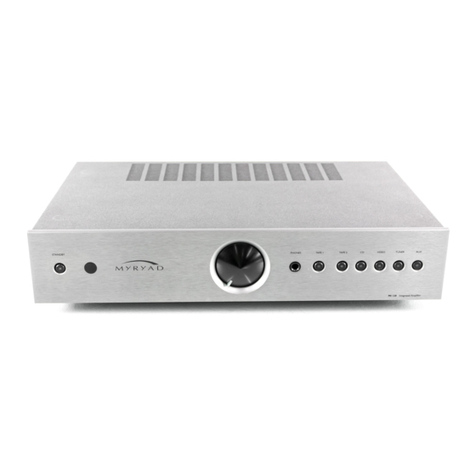
Myryad
Myryad mi 120 User manual
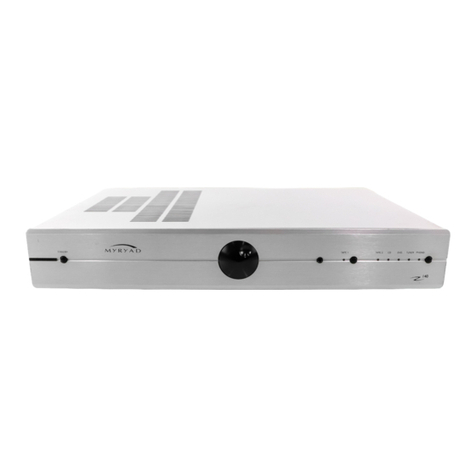
Myryad
Myryad Z140 User manual

Myryad
Myryad MXA0151 User manual
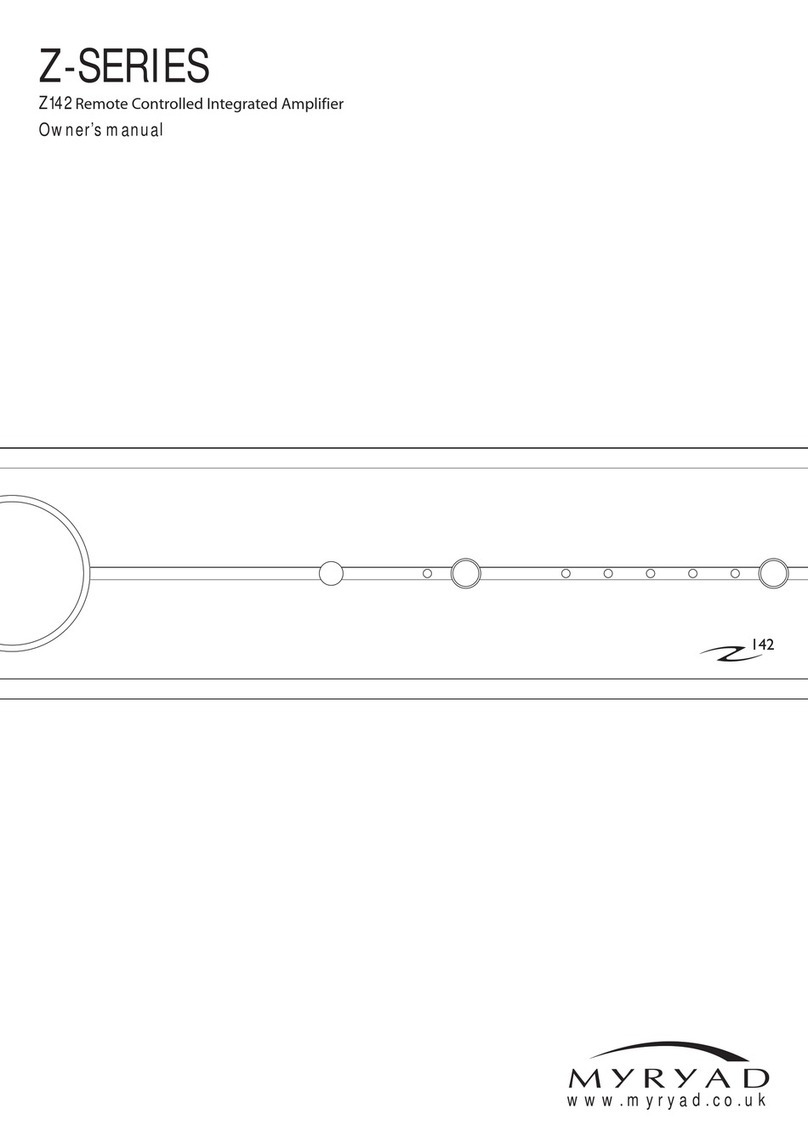
Myryad
Myryad Z142 User manual
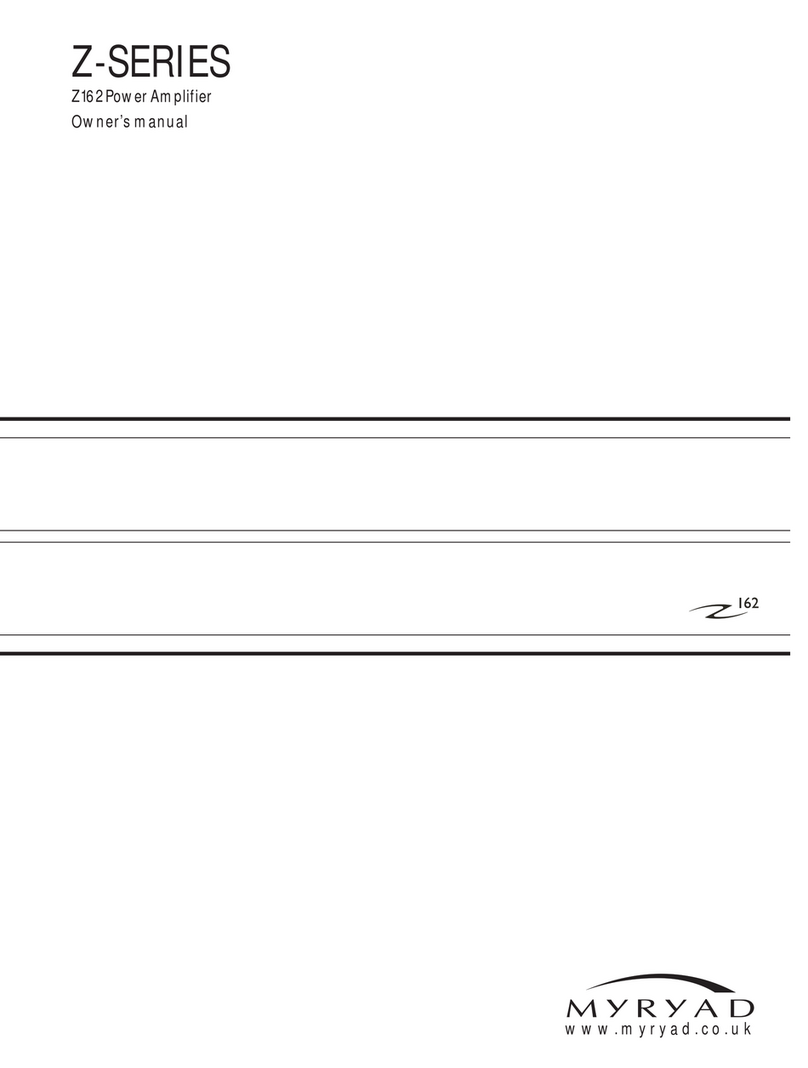
Myryad
Myryad Z162 User manual
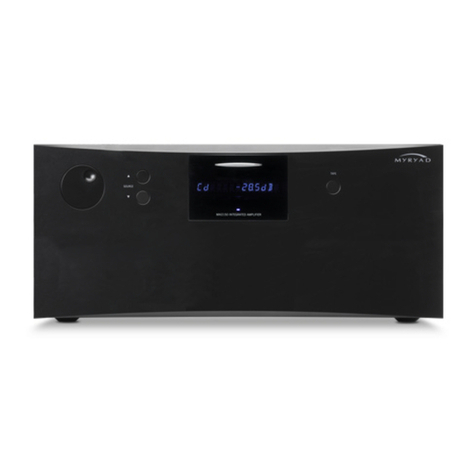
Myryad
Myryad MX Series User manual
